Saturday, September 12, 2020: 9:06 AM – 10:18 AM
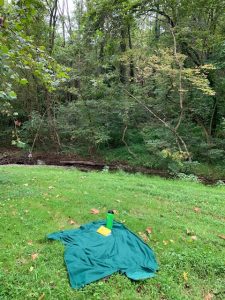
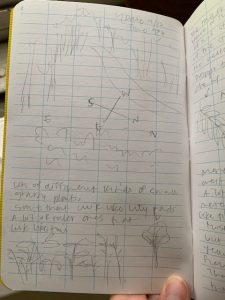

Being near water was important to my sit-spot choice. I first encountered the pond covered in algae but found it was rather close to foot traffic and did not particularly feel like observing the progress of eutrophication. As I continued along the western part of the loop, I encountered a nice place to settle down as my sit spot. It offered a buffer from the foot traffic of the loop in the slight descent it took to get to the spot; a grassy area with a few trees surrounding it, the stream to the west of it, and the forest beyond it. I liked that the trees rising up from the eastern bank of the stream offered me a sentiment of secrecy. I felt enclosed in a private space, surrounded by springy vegetation and a surplus of the color green. The greenery of this spot was particularly compelling. I was surrounded in green! The ground was covered in plants that seemed to be more than your average front lawn grass. The trees reached up towards the sky in green foliage; across the stream they grew without pattern or plans, a dense bush of green. In this sit spot, I felt nature arching her fingers above me, surrounding me in this little enclosed patch of her palm.
Within my few minutes of settling down in my sit spot, I heard what sounded to me like the bleating of a lamb or a goat. The sound was followed by the appearance of a deer coming from the northern side of the western bank (across the stream). The deer evidently noticed the appearance of an intruder and swiftly departed further west away from me, still bleating. My extensive knowledge of deer suggested to me that the deer was a fawn looking for its mother. Following the deer’s departure, I was quickly enveloped in a fixation with the grass surrounding me. It wasn’t your standard grass that trimmed suburban homes. They were wild here and so much more. There was a scattering of plants that looked like lily pads; a skinny stem leading up to a wide circular pad. There were also plants that had narrow and oval shaped leaves sprouting out on either side of its stem. Perhaps it is the fact that I come from southern California where the ground is dry dirt or manicured grass lawns, but I was intrigued by the variety of “grass” I saw on the sit spot ground.
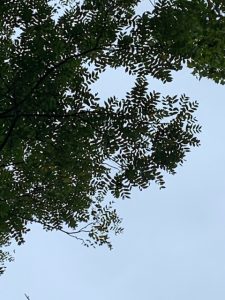 I also enjoyed examining the leaves of the trees on the eastern bank, where I was sitting, which framed the sky. The first tree had leaves that were long and oval like. They were neatly spaced out on the branches of the tree. They were mesmerizing while the wind was blowing; dancing and jiggling in the wind. The sky was overcast that morning; seemingly blanketed in one endless streak of grey. There were slightly brighter patches of grey in the sky, from which sunlight permeated through, but for the most part it was a never-ending swirly expanse of grey. While observing the sky, I heard a myriad of bird calls. I could not identify which calls belonged to which bird but I could distinguish the crows’ “caws” (at least I believe them to belong to the crows). Further into my time at my sit-spot, I saw birds landing in the bare branches of the trees on the eastern bank. They soon got up and flew off with a crowd of birds heading southwest. One lone bird was left in the branches until he too finally left with the last two stragglers.
I also enjoyed examining the leaves of the trees on the eastern bank, where I was sitting, which framed the sky. The first tree had leaves that were long and oval like. They were neatly spaced out on the branches of the tree. They were mesmerizing while the wind was blowing; dancing and jiggling in the wind. The sky was overcast that morning; seemingly blanketed in one endless streak of grey. There were slightly brighter patches of grey in the sky, from which sunlight permeated through, but for the most part it was a never-ending swirly expanse of grey. While observing the sky, I heard a myriad of bird calls. I could not identify which calls belonged to which bird but I could distinguish the crows’ “caws” (at least I believe them to belong to the crows). Further into my time at my sit-spot, I saw birds landing in the bare branches of the trees on the eastern bank. They soon got up and flew off with a crowd of birds heading southwest. One lone bird was left in the branches until he too finally left with the last two stragglers.
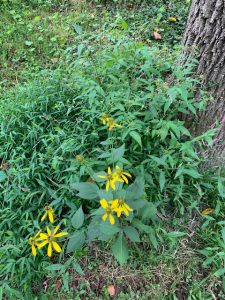
I chose to observe a yellow flowering plant, which I believe to be Rudbeckia laciniata, otherwise known as the Green-headed coneflower. It seemed to be coming to the end of its flowering, but its bright splash of yellow against all the green caught my eye. Its center was a surprising green-yellow, while its surrounding yellow petals had started to come off. This plant seemed to signal the coming of fall.
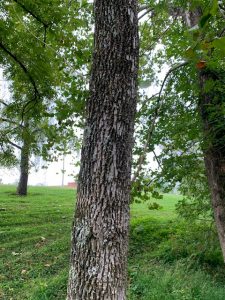
Another plant, or more so tree, that caught my eye was one of the few on the eastern side, a tree that looked like it was dying. The branches were short and stubby and yielded no leaves. The bark was mottled and uneven with what looked like moss growing up it. I am interested to see if this tree is truly dying, leaving me to be the observer of its slow death and decomposition, or whether, perhaps, it will come to rejuvenate. Another possibility is it’s doing perfectly fine and I simply do not know much about trees or indicators of their health.
My final object of observation
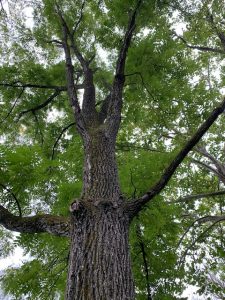 is the big beautiful tree, the other resident tree of the eastern bank. This tree was the owner of the aforementioned mesmerizing leaves. Its bark was an even color accompanied by an even texture. A couple of the lower limbs seemed broken off, void of leaves. Its branches were longest and fullest on the side facing east toward the loop and the school. Its leaves were beautiful and full, a green-yellow color, clinging on to the remnants of summer.
is the big beautiful tree, the other resident tree of the eastern bank. This tree was the owner of the aforementioned mesmerizing leaves. Its bark was an even color accompanied by an even texture. A couple of the lower limbs seemed broken off, void of leaves. Its branches were longest and fullest on the side facing east toward the loop and the school. Its leaves were beautiful and full, a green-yellow color, clinging on to the remnants of summer.

Oh my gosh you saw a deer!I’m actually pretty jealous of your sit-spot. I’ve seen the deer around campus, but never up close and personal like that. Your spot is beautiful and I love the yellow flowers that you chose to follow. Your blog is written so well, too. Nice ☺️
Great job Ellie – I love your spot and the process you went through to find it. The leaves of the tree make me think you could have a walnut – might want to see if that fits. I really enjoyed the detail you presented in your blog – I could connect to your experience. Well done